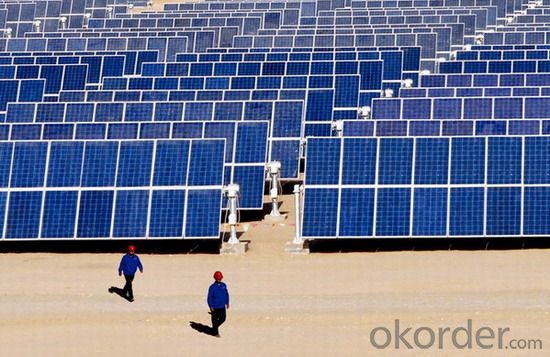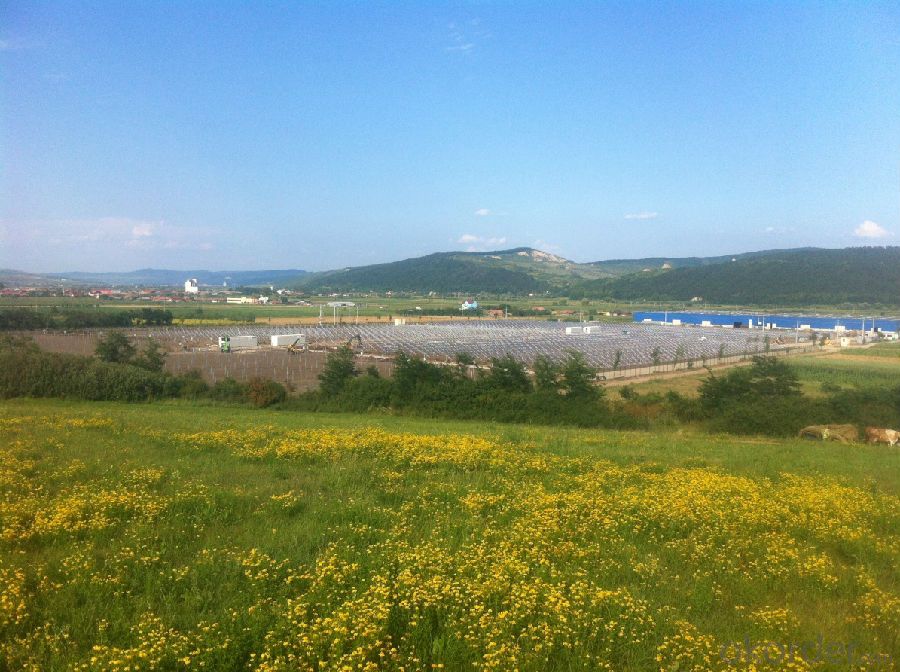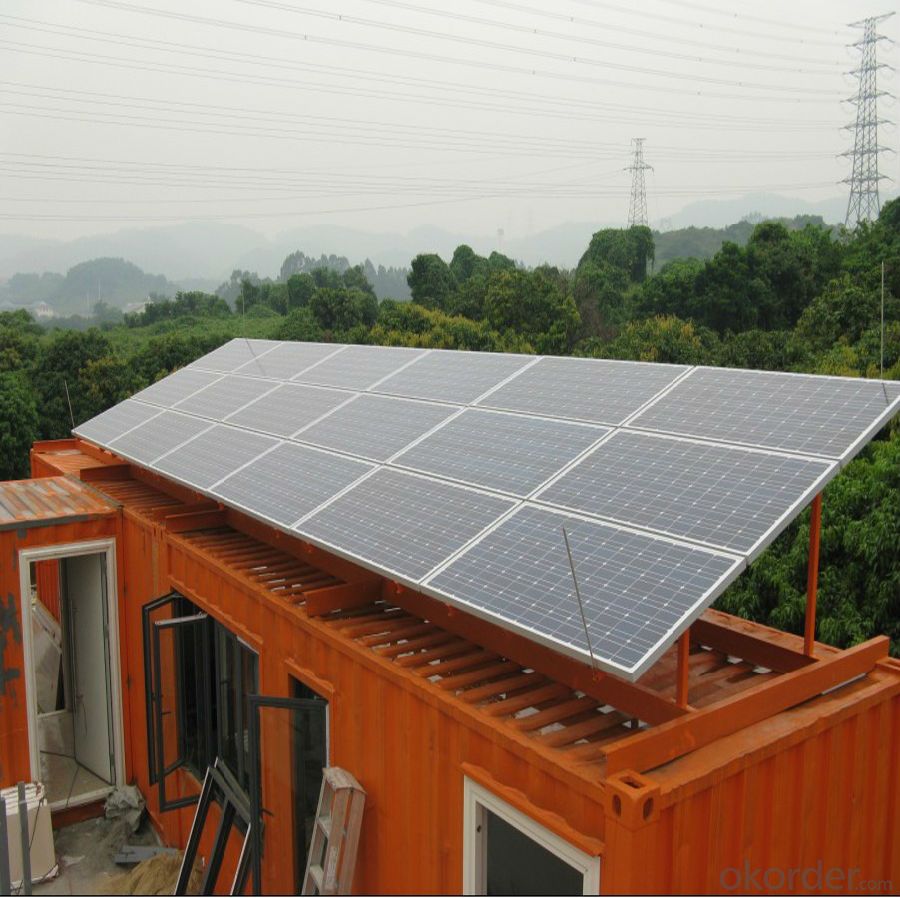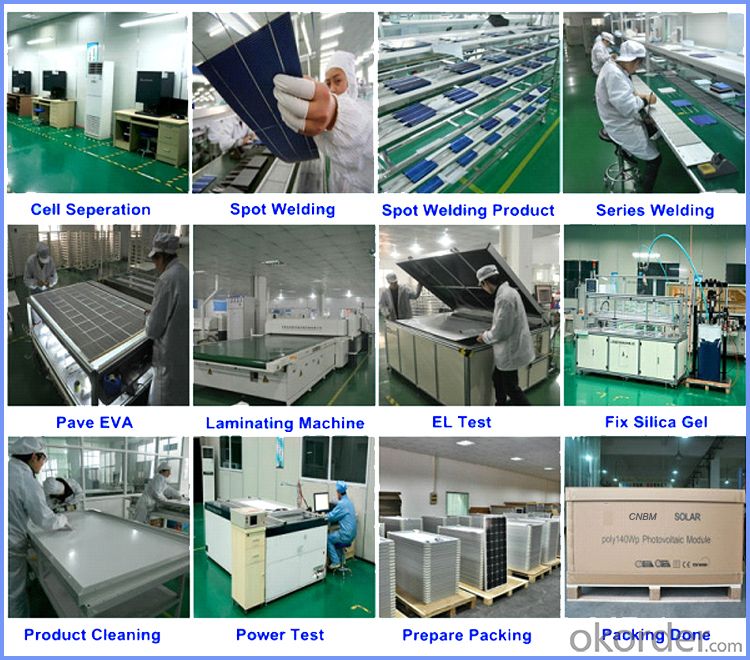CE and TUV Approved High Efficiency 250W Mono Solar Panel
- Loading Port:
- Shanghai
- Payment Terms:
- TT OR LC
- Min Order Qty:
- 10000 watt
- Supply Capability:
- 20000000 watt/month
OKorder Service Pledge
OKorder Financial Service
You Might Also Like
Item specifice
Product Description:
1.Structure of Polycrystalline Silicon Solar Panel
I. High efficiency crystalline silicon solar cell. Even if under the weak light, the solar module can produce maximum power output.
II. Tempered glass (toughened glass): Anti-reflecting coating and high transmission rate glass increase the power output and mechanical strength of solar module.
III. EVA and TPT: Using high quality EVA and TPT to prevent destroying and water.
IV. AI frame: Without screw, rner connection. 6 holes on the frame can be installed easily.
V. Junction box: Multi function junction box with water proof.
VI. Long lifetime: ≥25 years; Less power decrease.
VII. Good performance of preventing from atrocious weather such as wind and hails.
VIII. Resisting moisture and etching effectively, not effected by geology.
IX. The certificate issued by international authority: UL, TUV, IEC, CE.
2.Characteristics
1)Manufactured according to international quality and Environment Management
System (ISO9001, ISO14001)
2)High efficiency crystalline silicon solar cells
3)High transmission Iow iron tempered glass, strong mechanical resistance
4)Anti-ageing EVA and excellent anti-climate back sheet
5)Anodized aluminum frame improves load resistance capabilities for heavy wind loads.
6)Standard waterproof junction box
7)High endurance to different weather
8)Good and friendly package with less transportation and storage space.
3.Warranty
1)10 years limited manufacturing warranty
2)10 years for 90% of warranted minimum power
3)25 years for 80% of warranted minimum power
4.The Pictures of Solar Panels



5. Production Flow

6. Packing Details

7. Use For

- Q:When you add a load resistor to a PV panel (Solar panel) of 00 ohms what happens to the voltage produced from the cellAlso, as the resistance increases, how does this affect the output voltage
- Photovoltaic cells have a load curve that gives the power conversion based on the current drawn. This makes it harder to calculate. For instance, at infinite resistance, the solar cell will have a peak voltage that produces no power (P=I*V=V^2/r). At short circuit, the voltage collapses to essentially nothing and so the power is almost nothing. There is an optimal load (sweet spot) where the resistance applied will draw the most power out of the cell while not overloading it. This measure is either given by the manufacturer or found experimentally. Upon taking a lit panel that has no load and applying a 00 ohm resistance, the voltage will drop. By how much is entirely dependent on the array layout and specific cell characteristics. As the resistance drops from the optimal load point, the voltage collapses fairly sharply. As the resistance increases from the optimal load point, the voltage will rise more at first and then level off to the peak or no-load voltage.
- Q:Can solar panels be used for powering Wi-Fi networks?
- Yes, solar panels can be used to power Wi-Fi networks. Solar panels generate electricity from sunlight, which can be used to power various devices, including Wi-Fi routers. This allows for the establishment of Wi-Fi networks in remote or off-grid locations where traditional power sources are either unavailable or unreliable. Additionally, solar-powered Wi-Fi networks are environmentally friendly and sustainable, as they utilize renewable energy sources.
- Q:Can solar panels be installed on art installations or sculptures?
- Yes, solar panels can be installed on art installations or sculptures. In fact, integrating solar panels into art installations and sculptures has become a popular trend in recent years. This allows for the creation of sustainable and eco-friendly artworks that can generate renewable energy. Additionally, the combination of solar panels and art offers an innovative way to raise awareness about renewable energy and environmental issues.
- Q:Can solar panels be used to power a concert venue?
- Yes, solar panels can be used to power a concert venue. By installing a sufficient number of solar panels, a concert venue can generate enough electricity to meet its power requirements, including stage lighting, sound systems, and other electrical equipment needed for the event. Additionally, solar panels can help reduce the venue's carbon footprint and dependence on traditional energy sources, making it a more sustainable and environmentally friendly choice.
- Q:Mono-crystalline or poly-crystalline solar panel?
- All solar photovoltaics drop in efficiencies with higher temperatures but it isn't the 45+ C you have to worry about but rather the heat from the sunlight striking the panels. There are hybrid systems which passes water in pipes attached to the back of the solar panels to cool the panels and preheat the water for solar thermal collectors. The difference between mono-crystalline and poly-crystalline are that mono-crystalline are more efficient and more costly to make.
- Q:Can solar panels be used in areas with high levels of wind-blown debris?
- Yes, solar panels can be used in areas with high levels of wind-blown debris. However, it is important to install the panels in a way that minimizes the impact of the debris. This can be achieved by using protective measures such as installing wind deflectors or choosing panels with stronger frames and tempered glass. Regular maintenance and cleaning may also be required to ensure optimal performance in such conditions.
- Q:I'm doing a project for school where I will buy a solar panel and utilize/improve the power output of the panel. I want the panel to have an improved amount of energy output compared to the original. My budget for the solar panel itself is ~$00. Anything else that will be needed is covered.Also, I will be comparing the power by lighting a light bulb and checking to see the output energy of the panel.Where or how should I approach this project?What are the parts of the solar panel that I will need to buy?What factors could I change/improve to improve the overall energy output?What are the things (other than the panel) that I will need to buy?How can I attach a light bulb to the solar panel?
- Solar okorder /
- Q:What is the difference between on-grid and off-grid solar systems?
- The main difference between on-grid and off-grid solar systems lies in their connection to the traditional electrical grid. On-grid solar systems are connected to the grid, allowing them to both generate and consume electricity from the grid when needed. They can also feed excess electricity back into the grid, earning credits or compensation through net metering. In contrast, off-grid solar systems are not connected to the grid and operate independently, relying solely on solar energy to generate and store electricity in batteries for use when the sun is not shining. Off-grid systems are typically used in remote areas where grid connection is not available or for those seeking complete energy independence.
- Q:Can solar panels be used in areas with limited access to electricity?
- Yes, solar panels can be used in areas with limited access to electricity. Solar panels can generate electricity from sunlight, allowing them to provide a reliable source of power in remote or off-grid locations. These areas can benefit greatly from solar energy as it is a sustainable and renewable resource that can help meet their energy needs.
- Q:I am curious about how much of the energy that a solar panel of a given size and capacity will produce in it's lifetime, and what fraction of that energy was required to produce it in the first place?
- The attached link is to an article from the 200 Home Power magazine. In that article the energy payback was found to be between 2 and 4 years. Newer panels are more efficient primarily because the silicon wafers used today are thinner. The silicon cell embodies most of the energy required to make a solar panel. Today most solar panels will produce the amount of energy required to manufacture them in between about 9 months and 2 years depending upon the specific technology used to make it. Solar panels are expected to produce energy for between 30 and 50 years. Therefore it takes around 5% of their total energy production to produce them. Note that these figures depend upon where the panels are installed. Panels in very sunny areas may generate more than 3 times the energy of panels in a cloudier area. Edit - The energy payback meta-study that carbonates references below mention one particular study Alsema (2000), which the authors used as a baseline to come up with their 4 year payback figure. These studies DO NOT assume ideal conditions. The Alsema study assumes an annual an irradiation of 700 kWh/m2/yr. That is the United States average irradiation and does take into account cloudy weather and the like. Under idea conditions the amount of energy collected can be almost twice as much. Albuquerque New Mexico is an example. The figures I mentioned above are recent values reported by several different panel manufacturers with whom I discussed the issue at the 2006 IEEE 4th World Conference on Photovoltaic Energy Conversion held this May. The very long payback times that carbonate highlights are almost certainly wrong. The study he references concludes that paybacks range between 2 and 8 years with 4 years being the most likely. In my opinion payback times are actually a fair bit shorter based on conversations with the manufacturers.
1. Manufacturer Overview |
|
|---|---|
| Location | |
| Year Established | |
| Annual Output Value | |
| Main Markets | |
| Company Certifications | |
2. Manufacturer Certificates |
|
|---|---|
| a) Certification Name | |
| Range | |
| Reference | |
| Validity Period | |
3. Manufacturer Capability |
|
|---|---|
| a)Trade Capacity | |
| Nearest Port | |
| Export Percentage | |
| No.of Employees in Trade Department | |
| Language Spoken: | |
| b)Factory Information | |
| Factory Size: | |
| No. of Production Lines | |
| Contract Manufacturing | |
| Product Price Range | |
Send your message to us
CE and TUV Approved High Efficiency 250W Mono Solar Panel
- Loading Port:
- Shanghai
- Payment Terms:
- TT OR LC
- Min Order Qty:
- 10000 watt
- Supply Capability:
- 20000000 watt/month
OKorder Service Pledge
OKorder Financial Service
Similar products
New products
Hot products



























